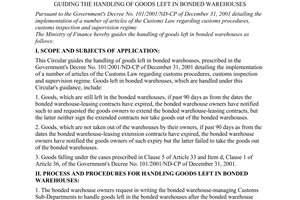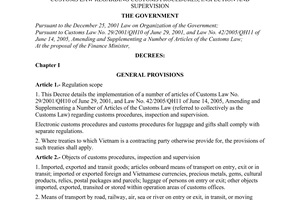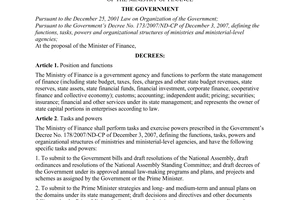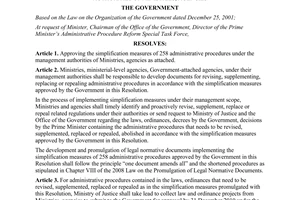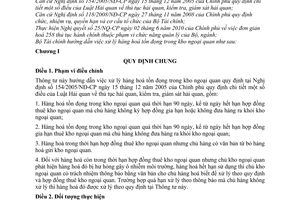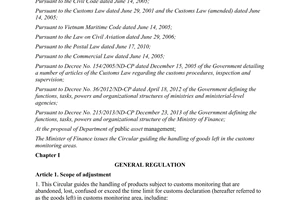Circular No. 195/2010/TT-BTC guiding the handling of goods left đã được thay thế bởi Circular No. 15/2014/TT-BTC guidance on handling of goods left in the customs monitoring area và được áp dụng kể từ ngày 15/03/2014.
Nội dung toàn văn Circular No. 195/2010/TT-BTC guiding the handling of goods left
|
THE
MINISTRY OF FINANCE |
SOCIALIST
REPUBLIC OF VIET NAM |
|
No. 195/2010/TT-BTC |
Hanoi, December 06, 2010 |
CIRCULAR
GUIDING THE HANDLING OF GOODS LEFT AT BONDED WAREHOUSES
Pursuant to the Government's
Decree No. 154/2005/ND-CP of December 15, 2005, detailing a number of articles
of the Customs Law regarding customs procedures, inspection and supervision;
Pursuant to the Government's Decree No. 118/2008/ND-CP of November 27. 2008,
defining the functions, tasks, powers and organizational structure of the
Ministry of Finance;
In furtherance of the Government's Resolution No. 25/NQ-CP of June 2, 2010, on
simplification of 258 administrative, procedures falling within the scope of
managerial functions of ministries or sectors;
The Ministry of Finance guides the handling of goods left at bonded warehouses
as follows:
Chapter I
GENERAL PROVISIONS
Article 1. Scope of regulation
This Circular guides the handling of goods left at bonded warehouses provided for in the Government's Decree No. 154/ 2005/ND-CP of December 15, 2005, detailing a number of articles of the Customs Law regarding customs procedures, inspection and supervision, including:
1. Goods left at bonded warehouses beyond the time limit of 90 days after the expiration of bonded warehouse-leasing contracts but goods owners decline to renew the contracts or to bring their goods out of the bonded warehouses.
2. Goods left at bonded warehouses beyond the time limit of 90 days after the expiration of the contracts for extension of bonded warehouse lease but goods owners decline to bring their goods out of the bonded warehouses.
3. Goods kept within the bonded warehouse-leasing term but abandoned by goods owners as notified in their documents sent to bonded warehouse owners.
4. For goods still kept within the bonded warehouse-leasing term but detected by bonded warehouse owners as being rotten, polluting the environment or with expired use dates, the bonded warehouse owners shall notify such in writing to the goods owners for handling according to regulations and bonded warehouse-leasing contracts. If past the notified handling time limit, the goods owners fail to handle them, such goods shall be handled under this Circular.
Article 2. Subjects of implementation
1. Bonded warehouse owners.
2. Customs Departments, Customs Sections managing bonded warehouses.
3. Councils for handling of goods left at bonded warehouses.
4. Owners of goods deposited at bonded warehouses.
5. Other subjects involved in the handling of goods left at bonded warehouses.
Chapter II
HANDLING OF GOODS LEFT AT BONDED-WAREHOUSES
Article 3. Notification of goods deposited at bonded warehouses
1- At least .1.5 days before the contracts on bonded warehouse lease or bonded warehouse lease extension expire, the bonded warehouse owners shall notify in writing the goods owners and bonded warehouse-managing district-level Customs Departments that the warehouse-leasing contracts or warehouse lease extension contracts are due to expire.
2. Quarterly (within the last 15 days of the quarter), the bonded warehouse owners shall report to bonded warehouse- managing district-level Customs Departments on the situation of goods left at bonded warehouses according to the form attached to this Circular (not printed herein). In case exist goods as provided for in Article 1 of this Circular, the bonded warehouse owners shall compile dossiers proposing the handling of such goods and send them to the bonded warehouse-managing Customs Sections for handling.
In case the time for periodical report has not reached but the goods to be handled are rotten and polluting, or goods with expired use dates or to be expired within less than 45 days, the bonded warehouse owners shall compile dossiers for handling within three working days after the detection thereof.
Article 4. Dossiers of proposing the handling of goods left at bonded warehouses
1. A dossier proposing the handling of goods left at a bonded warehouse shall be made in two (2) sets; one (1) set is sent to the bonded warehouse-managing district-level Customs Department and one (1) set kept at the bonded warehouse.
2. A dossier proposing the handling of goods left at bonded warehouse comprises:
a/ The official letter proposing the handling of goods left at bonded warehouse sent by the bonded warehouse owner to the bonded warehouse-managing district-level Customs Department: The original;
b/ The bonded ware house lease contract; the bonded warehouse lease extension contract (if any): A copy:
c/ Notices of the bonded warehouse owner to the goods owner (if any): copies;
d/ Goods owner's document on abandonment of goods deposited at the bonded warehouse (if any): A copy:
e/ Inventories of the quantity, types and specifications goods left the at bonded warehouse, serial number of the ware house-leasing contract, serial number/date of the declaration of goods brought into or out of the bonded warehouse: The original;
f/ Other papers and documents related to the goods deposited at the bonded warehouse.
3. The copies defined at Points b. c, d and f of Clause 2. this Article, shall be signed for certification and stamped by bonded warehouse owners.
Article 5. Council for handling of goods left at bonded warehouses
1. Within five days after the receipt of bonded warehouse owners' dossiers proposing the handling of goods left at bonded warehouses as provided for in Clause 2, Article 4 of this Circular, the bonded warehouse- managing district-level Customs Department shall propose the Directors of Customs Departments of provinces or centrally run cities ( in which the bonded warehouses are located) to set up Councils for handling of goods left at bonded warehouses (below referred to as the Handling Councils), each with the following members:
a/ The Council chairman: A leading official of the provincial-level Customs Department;
b/ The Council vice-chairman: A leading official of the bonded warehouse-managing district-level Customs Department;
c/ Members:
- The bonded warehouse owner or representative authorized by the bonded warehouse owner:
- The representative of the Finance Department of the province or centrally run city (in which the bonded ware-house is located);
- Representatives of concerned units (if necessary).
2. The number of Council members will be decided by the Director of the provincial-level Customs Department at the proposal of the bonded warehouse- managing district-level Customs Department, based on the volume and nature of left goods as well as the tasks to be performed. In the course of operation, the Handling Council may use the stamp of the provincial-level Customs Department in its operation.
3. The Handling Council will automatically dissolve after accomplishing its tasks as provided for in the decision on its establishment.
In case of necessity, based on the practical handling of goods left at bonded warehouses, the Director of the provincial-level Customs Department may set up a Council for handling of goods left in stock at bonded warehouses for each year to handle goods left at bonded warehouses, which fall under their respective management and arise in that year.
Article 6. Order of handling goods left at bonded warehouses
1. To inventory, classify and draw up plans on handling of goods left at bonded warehouses:
Within 15 days after the issuance of decisions on their establishment, the Handling Councils shall complete the procedures for breaking the seals on warehouses, goods or containers (if any). tallying the quantity of goods physically left at bonded warehouses, classifying them and determining their value (if handling them in form of sale) in order to draw up plans for handling according to the following regulations:
a/ For goods having no more use value (decayed, broken, damaged, deteriorated in quality, use- expired, poor-quality for use) or being banned from circulation according to Vietnamese law, the destruction thereof will be carried out;
b/ For goods banned from import according to law. the Handling Councils shall transfer the dossiers to functional bodies for handling according to law:
c/ For goods not defined at Points a and b of this Clause, they will be put on sale.
If goods defined at this Point arc on the list of conditionally imported goods, the Handling Councils shall propose the provincial-level Customs Department to report thereon to competent bodies for permitted importation.
The valuation for use as a basis for making handling plans defined in this Clause is based on the residual quality of goods and the sale prices of brand-new goods of the same type. The valuation methods comply with the Goods and Service Price Calculation Regulations promulgated by the Ministry of Finance.
In the course of performing the tasks defined in this Clause, when necessary, the Handling Councils may hire appraisal organizations lawfully set up and operating to appraise goods quality, which serves as a basis for making plans for handling of assets and determining their value.
2. The sale of goods left at bonded warehouses will be carried out through public auction according to law. except the following cases in which direct sale is permitted (not via auction):
a/ Perishable goods or goods with the expiry dates shown on their labels or enclosed dossier accompanying documents remaining for less than 30 days;
b/ Goods of under VND 50 million/lot as evaluated by the Handling Councils.
3. Within 15 days after the accomplishment of tasks defined in Clause 1 of this Article, the Handling Councils shall organize the handling of assets as follows:
a/ For lo be-destroyed goods: The organization of destruction must be recorded in writing by the Handling Councils and the bonded warehouse owners will be assigned to destroy such goods to the witness of the Handling Councils. In case of necessity, the Handling Councils shall invite concerned state management bodies to witness the destruction.
For goods the destruction of which will impact the environment, the approval and guidance of local environment management agencies must be obtained before the destruction.
A destruction record has the following basic contents: grounds and reasons for destruction; destruction time and place; participants in the destruction; names, catergories, quantity and conditions of goods at the time of destruction; form of destruction and other relevant contents.
b/ For goods on direct sale: Based on the goods values determined in Clause 1 of this Article, the Handling Councils shall organize the sale thereof to organizations and individuals wishing to purchase.
The goods sale must be recorded in writing. A sale record has the following major contents: grounds for sale; sale time and location; seller; names, categories, quantity, conditions of goods at the time of sale; unit sale prices, payment value; buyers and other relevant contents.
c/ For goods put on auction: The reserve prices for organization of auctions are the prices set by the Handling Councils under the provisions of Point c. Clause 1 of this Article. The order of, and procedures for, auction of goods left in stock at bonded warehouses comply with the law on auction of assets. The Handling Councils may directly organize the auctions or hire professional auctioning organizations (asset auction service centers or asset auction enterprises) to carry out the auctions.
d/ The direct sale prices and the auction-winning prices defined at Points b and c of this Clause are inclusive of taxes payable by buyers under law.
4. When selling goods left in stock at bonded warehouses, defined at Points b and c. Clause 3 of this Article, the Handling Councils shall:
a/ Deduct money amounts from goods sale revenues for payment of taxes under law. Tax rates comply with regulations at the time the buyers register customs declarations with customs offices. Payable tax amounts are based on the actual prices of goods left at bonded warehouses sold to buyers. Tax calculation methods and applicable taxes (value-added tax. excise lax, import duty...) comply with tax laws;
b/ Guide goods buyers to carry out procedures for transportation of goods from bonded warehouses into the inland and supply sets of dossiers for buyers to carry out customs procedures (compile dossiers) for import of goods into the inland, including:
- Goods sale record (for cases of direct sale) or asset auction record (for cases of auction): the original:
- The contract on trading in goods left at bonded warehouses between the Handling Council and goods buyers: the original;
- Sale invoice: the original;
- Warehouse delivery bill: the original;
-The Handling Council's written certification of fulfillment of tax obligations: the original;
- The declaration on goods brought into and delivered from bonded warehouses: A copy;
- The bill of lading: A copy.
The copies must be signed for certification and stamped by the Handling Council.
Chapter III
FINANCIAL MANAGEMENT OF THE HANDLING OF GOODS LEFT IN STOCK AT BONDED WAREHOUSES
Article 7. Management of proceeds from the sale of goods left at bonded warehouses
The whole proceeds from the sale of goods left at bonded warehouses shall be paid into temporary custody accounts of the Customs Departments of provinces or centrally run cities (in which the bonded warehouses are located) opened at the State Treasury.
Article 8. Expenses related to the handling of goods left in bonded warehouses
1. Payment of import and export duties, excise tax, value-added tax and other taxes (if any) under law.
2. Hire of services related to (he handling of goods left at bonded warehouses, including expenses for hire of quality assessment, expenses for information and advertisement, expenses for printing of auction documents and dossiers. auction charges (in case of hiring professional auctioning organizations).
3. Bonded warehouse service expenses (if any).
4. Payment of allowances to members of the Handling Councils in the course of handling goods left at bonded warehouses (inventory, classification, assessment, valuation, ma king of handling plans, organization of goods handling), not exceeding VND 70.000/day/person.
Article 9. Settlement
1. Provincial-level Customs Departments shall, based on the reasonability and regularity of expenses related to the handling of goods left at bonded warehouses, control relevant dossiers and vouchers and propose the State Treasury to make payments, which must comply with the priority order stated from Clause 1 to Clause 4. Article 8 of this Circular, and shall take responsibility for their decisions.
At the end of a budget year, the proceeds from the from sale of goods left at bonded warehouses in the temporary custody accounts of the provincial-level Customs Departments (of localities where the bonded warehouses are located), opened at the State Treasury, defined in Clause 1. Article 7 of this Circular, after deducting the expenses defined in Article 8 of this Circular, shall be. paid into the state budget under the law on decentralization of state budget management.
If the proceeds from the sale of goods left at bonded warehouses at a time of handling is not enough for payment of all expenses, the payment shall be made in the priority order staled from Clause 1 to Clause 4, Article 8 of this Circular.
If the proceeds from the sale of goods left at bonded warehouses, after being deducted for payment of taxes (if any) under law. is not enough for payment of the expenses defined in Clause 2. Article 8 of this Circular, the Handling Council shall report thereon to the provincial-level Customs Department for decision on the use of the remaining money amounts in the temporary custody accounts for payment of expenses defined in Clause 2. Article 8 of this Circular; if the temporary custody account is fully reduced, the deficit amount will be paid by the provincial-level Customs Department within the assigned budget estimate for payment.
2. For to be-destroyed goods at bonded warehouses, the bonded warehouse owners shall advance money for the destruction. After the destruction, the bonded warehouse owners shall notify the goods owners thereof for payment of all expenses related to the destruction to the bonded warehouse owners. If the goods owners abandon their goods and refuse to pay. the bonded warehouse owners may account their money which were advanced but irrecoverable as expenses of the bonded warehouses.
Chapter IV
IMPLEMENTATION ORGANIZATION
Article 10. Implementation provisions
1. This Circular takes effect on January 20, 2011.
2. To annul Circular No. 36/200.VTT-BTC of April 16, 2003, of the Ministry of Finance, guiding the handling of goods left at bonded warehouses.
3. Any problems arising in the course of implementing this Circular should be reported to the Ministry of Finance for coordinated settlement.-
|
|
FOR
THE MINISTER OF FINANCE |
